Holiday 2010 System Builder's Guide
by AnandTech Staff, edited by Jarred Walton on November 19, 2010 2:00 AM EST- Posted in
- Guides
- Systems
- Holiday 2010
| Brian's Intel Dream PC | ||
| Hardware | Component | Price |
| Processor |
2x Intel Xeon X5660 Westmere 32nm (Hex-core + HTT, 2.8 to 3.2 GHz, 12MB L3, 95W) |
2x $1225 |
| CPU HSF | 2x Xigmatek Dark Knight-S1283V | 2x $45 |
| Motherboard |
EVGA Classified SR-2 (Intel 5520, ICH10R, 270-WS-W555-A2) |
$590 |
| GPU | 2x EVGA SuperClocked GTX 580 | 2x $530 |
| Hard Drives | 4x Western Digital 1.5TB (WD1501FASS) | 4x $120 |
| OS Drive (SSD) | OCZ RevoDrive X2 240GB PCI-E 4x SSD | $680 |
| Memory | 2x Patriot 12GB (3x4GB) DDR3 1333 | 2x $360 |
| Power Supply | Antec TPQ-1200 80 Plus Silver | $250 |
| Case | Lian Li PC-V2120X ATX Full Tower | $500 |
| Optical Drive | LG 10x Blu-Ray Burner w/Lightscribe | $100 |
| Keyboard | Das Keyboard Professional Model S Silent | $135 |
| Alt Keyboard | Logitech G510 Keyboard | $100 |
| Mouse | Razer Mamba 5600 DPI Wired/Wireless | $130 |
| Monitor | Dell U3011 30" 2560x1600 IPS | $1350 |
| Sound Card | Creative 7.1 24-bit PCI-E X-Fi Titanium | $75 |
| Total System Price | $8610 | |
When I heard that the whole AnandTech staff was going to get to put together a rig of their choice, I instantly gravitated to the super high end. Heck, there's no reason you can't at least ask for the absolute best, even if you know it's out of your price range. For others, maybe you really do want to go sky high and push the limits of what's possible with desktop parts without getting too exotic. Either way, this dream machine build isn't for the faint of heart.
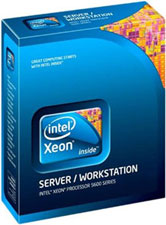
I've configured and built a number of dual processor Xeon 56xx series workstations in the past, yet each time destined for a fairly mundane existence doing computational modeling or some other serious business. Each time I'm finished, there's a brief but overwhelming temptation to install Crysis, Metro 2033—heck, something!—with all the eye candy on max with a 2560x1600 display. Each time, I shake that thought away right after finishing burn-in testing as I pop in the latest version of whatever *nix flavor is appropriate. I kid myself that maybe eventually I'll be able to build something like this without having to justify every bit of it as being vitally critical for modeling complicated scientific something or other. Anyway, if you've got nearly limitless piles of sweet cash lying around, this is the rig for you.
Starting out is really the motherboard. Initially, I wanted to go with a server-class motherboard, the SupermicroMBD-X8DTi, having worked with it and similar workstation boards in the past. If you want a dual CPU motherboard, the options basically dictate either a similar class of "server" motherboard like theMBD-X8DTi from Supermicro, something comparable from Tyan, or the only choice in the more conventional desktop class of products, the EVGA Classified SR-2. TheMBD-X8DTi and SR-2 are actually quite similar; both are built around the Intel 5520 and ICH10R chipsets, both are happy with an unreasonable number of triple 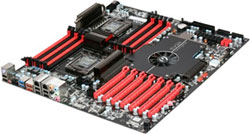 channel ECC or non-ECC DDR3-1333 memory, and both actually present similar PCI-E lane configurations. The Supermicro comes with onboard graphics, but we'd obviously recommend disabling that in the BIOS and forgetting about it. The Supermicro board costs $430, whereas the Classified SR-2 costs a slightly mind-bending $590. The difference between the two is ultimately whether you want SLI licensing so you can stick in some some multi-GPU goodness from NVIDIA. Remember that NVIDIA still requires either a BIOS key or NVIDIA bridge chip for SLI to work, both of which the cheaper Supermicro board lacks. AMD CrossFire remains feasible on both, but that difference, along with the more enthusiast-oriented features like overclocking support, ultimately led me to settle on the SR-2, despite its nose-bleed-inducing price tag.
channel ECC or non-ECC DDR3-1333 memory, and both actually present similar PCI-E lane configurations. The Supermicro comes with onboard graphics, but we'd obviously recommend disabling that in the BIOS and forgetting about it. The Supermicro board costs $430, whereas the Classified SR-2 costs a slightly mind-bending $590. The difference between the two is ultimately whether you want SLI licensing so you can stick in some some multi-GPU goodness from NVIDIA. Remember that NVIDIA still requires either a BIOS key or NVIDIA bridge chip for SLI to work, both of which the cheaper Supermicro board lacks. AMD CrossFire remains feasible on both, but that difference, along with the more enthusiast-oriented features like overclocking support, ultimately led me to settle on the SR-2, despite its nose-bleed-inducing price tag.
Of course, now that we've incurred such a large price premium to get a two-socket motherboard, we should stick in at least a couple hex-core CPUs, right? Two 6-core CPUs with Hyper-Threading gives a whopping 24 threads of power. For that, there's Intel Westmere—the SR-2 andMBX-X8DTi both support Xeon 5500 and 5600 series. At the most extreme, there's the 3.33GHz Xeon 5680, which runs $1725, but anyone can sort by price and see what's the most expensive, and we're still at least somewhat interested in performance per buck (or are we?) The Xeon 5680 can Turbo from 3.33GHz to 3.6GHz. Subjectively, the Xeon X5660 seems to be a better tradeoff between price and stock clock speed at 2.8GHz, plus you get a larger turbo boost up to 3.2GHz. Either way, the two CPUs will set you back a big chunk of change. As one reader pointed out, you also need a heatsink for Xeon, as it doesn't ship with one, so we grabbed a couple of Xigmatek Dark-Knight coolers.
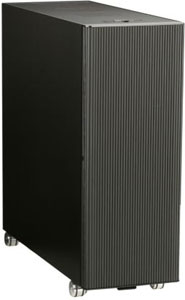
In the traditional workstation configuration, I usually opt for a Cooler Master Cosmos or Cosmos S, and when I think about what's really ultimate in the case market these days, my mind immediately settles on either the iconic Thermaltake Level 10 or the ABS Canyon 695. TheMBD-X8DTi and other workstation boards are E-ATX, which would fit in all the aforementioned cases but the Level 10. Unfortunately, the SR-2 is enormous and necessitated EVGA to define their own motherboard form factor entirely—HPTX—which is a mind-numbing 13.6" x 15". The result is that our case recommendation is limited unless you're willing to go custom or break out the Dremel. Luckily, there's a line of HPTX cases by Lian Li that are attractive and fit the SR-2 just fine. If you're opposed to finding a motherboard tray properly machined for HPTX or loath to do modifications yourself, the Lian Li PC-V2120X is what you should go for.
Moving along we come to the GPUs; I talked with Ryan on this to get his input, and ultimately we both agreed on 2xSLI GTX 580s. EVGA is (at time of this writing) offering the Superclocked version at 797MHz core/1594MHz shader clocks for prices on par with the competition's regularly clocked GTX 580s. The choice is simple at that point: go for the factory overclocked EVGA while it's still feasible.
Storage on a dream build would be incomplete without an SSD for the OS. Thankfully, the RevoDrive X2 is indeed bootable and thus makes an ideal drive for the OS and critical system apps. On every system I've built in recent memory, I've gone with an SSD + RAID array of slow but capacious storage; I think the same is best here. Get four or five 1.5TB or higher HDDs of whatever brand makes you feel warmest inside, toss them in a RAID5 set, and enjoy a crap-ton of storage that's fully redundant. I suppose if you're really feeling ultimate, you could get a RAID card instead of using the ICH10R's software fakeRAID, but it probably isn't critical unless you want to eek out everything you can from those mechanical drives.
My dream PC would be incomplete without at least 12GB of RAM—it's just that simple. I think it's safe to say that 6GB is pretty standard for midrange X58 gaming builds, with 8GB and 12GB starting to become the norm at the fringes. To stay safely ahead, you've got to move to 24GB, which is actually surprisingly common for workstations processing huge datasets that need to exist entirely in RAM. Of course, it's more than likely that no game will ever make use of the 24GB, but we're building the ultimate system here, right? The objective is to play Crysis within Crysis if we could. I settled on two sets of matched Patriot 12GB (3x4GB) kits, as all the 24GB (3x8GB) kits I could find were either sold out or lacked heat spreaders. You should still get triple-channel performance on either the SupermicroMBD-X8DTi or EVGA SR-2 with six populated memory slots, but it definitely makes me a little uneasy populating so many if you don't have lots of airflow.
For the power supply, we're big fans of the Antec TPQ-1200 Silver, which packs a half and half modular/fixed set of cables. It's a combination that provides the best of both worlds for not blocking airflow with unused power cables, and fixed cables for being absolutely certain connectors aren't a concern. The TPQ-1200 is (as the name implies) 1200W, which should be adequate for the SR-2, two Xeons, and two GTX 580s, plus all those mechanical drives.
I'm a fan of LG's 10x Blu-ray burner with LightScribe support, purely because it's SATA, well received, and I've built a number of systems with it in the past. You get DVD+/-R support at 16x, and CDR support at 48x, which is pretty standard. I'm a sucker for LightScribe support just because I always convince myself that the next batch of writeable disks I buy will also be LightScribe; sadly, I've somehow avoided ever doing it. Regardless, the optical drive is quickly becoming marginalized, but for your ultimate build, why not include one? Same thing with the sound card—you don't really need one anymore if onboard audio suffices, but if we're going for the ultimate, you might as well consider it.
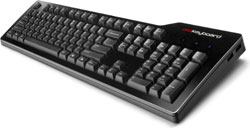
Since we're going all out, we'd be remiss if we didn't include suggestions for the peripherals as well. When I think of the ultimate keyboard, I immediately think of one keyboard—the Das Keyboard. If you haven't heard of it, chances are you've been living under a rock, or been blind sighted by all the flashy gaming-focused keyboards with copious amounts of LED lights but little attention to the mechanics of keydomes. If you want a gaming keyboard, get the Logitech G510—it's awesome and I have one—but if you're serious about typing, consider the Das Keyboard. Das Keyboard is essentially the modern IBM model M equivalent, and is a joy to type on purely because of the serious mechanical and aural feedback. For the mouse, I'm a huge fan of Razer. I worked my way from the Logitech MX1000 (the first laser mouse) through a number of Logitech and Razer mice alike, but keep settling back down on Razer. It's ultimately a matter of personal taste.
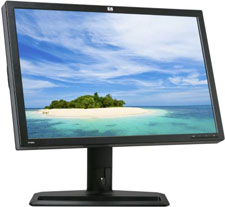
Last but certainly not least is the monitor. The choices here are quite obvious: either buy a 30" Dell U3011 or its archrival, the HP ZR30w. Both are IPS, both look superb, and both round out the dream configuration. Or maybe you need two 30-inchers? I've left out a fan recommendation since the stock fans for these Xeons have (thus far) seemed sufficient, but the usual Zalman 120mm or similar are always an option I'd encourage.
This configuration is again insane, but at the end of it all, I still find myself thoroughly convinced that if I had infinite monies, I'd put it together in a heartbeat—and maybe even splurge for that 3.33GHz Xeon 5680, regardless of the fact that it's overkill even for Crysis. If you had infinite cash or an appetite for the drooling-on-the-carpet insane—and need it right stinkin' now—this is the system I'd recommend, right after I note that Sandy Bridge is right around the corner. If this configuration is financially justifiable to you, by all means, do it! (And send us some benchmarks and pictures!) Alas, for me, it's still little more than a holiday dream.










112 Comments
View All Comments
Rumpelstiltstein - Friday, November 19, 2010 - link
These are all decent builds for the different price points, but I have a few suggestions for future system guides. Before I say anything else, I would just like to note that I am a big fan of your site, it is always a source of some great journalism and analysis of PC Hardware. Keep up the good work. However, when a PC Hardware site puts up a system guide, I like to use it as a source to send friends to that are thinking of building a new PC and I like to compare between different guides before deciding who to send them to. This is an area that I think you could improve in. I personally think that if you changed your approach to these guides a little bit, it would help out immensely. My model for comparison, since I have found it to be the most comprehensive guide out there is The Tech Report's system guide:http://techreport.com/articles.x/19868
This may or may not be the best example as recently released hardware has changed the game up a lot, but I think some of their guides in the past were pretty spot-on. Anyway, what these guys do is create a few budget tiers and all of the TR Staff debate over the best choice for each part, rather than assigning one person per build. I'm sure this could easily be accomplished by your editors. Sure, it might bring up some heated arguments, but I have no doubt that the final choices will be better overall. I understand that you have more builds here for a wider range of purposes, and that's great, but you can adapt this approach to accomplish the same goal. Even TR often has an alternate build every few months for a different audience. In this last one, they came up with a highly upgradable nettop-like system that is a good recommendation for those who would otherwise go out and purchase a system-in-a-box from the likes of HP or Dell.
Another thing they do is provide links to newegg, since newegg is a good place to determine the price you would likely pay for the overall build and it provides good user feedback for people to look at as well as a great wishlist system for people to plan their purchase with, whether or not they choose to do their final purchases through newegg. This is not as essential a feature, but it does help. Granted, they do have newegg's sponsorship, so they have more incentive to do this. But they have been doing it even before newegg took notice and decided to give their thumbs up.
They also put peripherals, accessories, and extras under a separate topic since these things really are very much user preference and don't necessarily depend on the system they are using them with. And of course, at the end they provide a conclusion to reflect on the changes and how the industry as a whole has changed since their last system guide to lead them to the hardware picks they have chosen for each build.
Again, I'm not suggesting you try to adhere to the formula used by another site, but there are things that can be learned by reading them. I think if you made a few of these changes, particularly the collaboration of all your staff on each build, you will provide a much better guide that more people will be apt to follow rather than just look at, have a chuckle, and do whatever they were gonna do before reading it. You will likely have less members crying "that is a horrible choice for that build, this would be better." Granted that particular person can make all the changes he wants to suit his personal preference, but they could just build their system from the ground up which would render such a guide useless. You might point a few in a better direction with a guide like this, but more knowledgeable people would likely take it with a grain of salt. I think with a better approach you can hit a larger audience with your guides. It's all about helping people make a good investment in their systems and pick good quality parts with a nice price/performance ratio within the limits of a given budget.
Iketh - Saturday, November 20, 2010 - link
Agree 100% with this... when i read the title, and then read who the author was (Anandtech staff), I thought i was gonna read about "the best of now" systems which all the authors collaborated... i was rather disappointed when i saw otherwise :(it IS fun to read about each author's particular taste (and hence get to know them a little better), but you can better demonstrate this if each system is chosen as a team, and then break down, in the explanation, what one author was fighting for in a particular build over another and the ensuing carnage :)... THAT would be fun to read, as well as explaining why eventually one part was chosen over the other
benrico - Friday, November 19, 2010 - link
This is a 32 nm chip... Improperly identified in the mid HTPC build.ERDoc - Friday, November 19, 2010 - link
The one system I'm waiting to build is a large NAS. Something with 20 drives, RAID 6, Blu-ray disc player for backing up my content and serving to multiple HTPCs. WHS Vail or Server 2008 would likely be the OS of choice. 2 x SSD RAID 0 as system drives. Now that 3TB drives are available (soon), are there any server boards will support SATA 6Gb/s, 3 TB drives? I was thinking a Norco 4220 as the case. Any other suggestions? Same for for processors (will be transcoding on the fly, 8 to 10 separate output streams True HD)?Dual GB ethernet at minimum. There are companies such as Vidabox selling systems like this for $10k to $15k. I think I could build a better system (with 2 TB drives) for less
Any other suggestions?
hglazm - Friday, November 19, 2010 - link
No. Stop right here. Do not, DO NOT do these. They are never unbiased, they are rarely good to suit users needs, they direct a tremendous amount of consumers to products they dont need or are too underpowered for, and they will end up degrading you into the likes of TomsHardware.Just stay the fuck away from these, guys. Don't do it.
hglazm - Friday, November 19, 2010 - link
Also, what the hell is up with recommend the Antec BP series?Stuffs a load of crap.
JarredWalton - Friday, November 19, 2010 - link
What are you talking about? This was a Holiday Buyer's Guide and we figured it would be nice to give everyone a voice for a change of pace. This is not intended to be the way we do buyers' guides going forwards, but instead is a large article that covers a huge swath of possibilities in time for Black Friday.As for the BP550, can you point me to any good review that shows it's a "load of crap"? The word on the street is that it's a decent Delta-built power supply. Is it the best PSU out there? No, but if you can pick it up for $35 with the current $30 combo at Newegg with the Antec Three Hundred case, it's a heck of a lot better than most other $35 PSUs. Best info I can find suggests there's nothing wrong with the BP550 (unless you're anti-Antec I suppose).
Bad_Wolf_Online - Friday, November 19, 2010 - link
I have a dual x5680 system, Brian asked for pictures and benchmarks how do I contact him?http://dl.dropbox.com/u/4974831/Cinebench_R11.5%28...
http://dl.dropbox.com/u/4974831/Windows_Task_Manag...
Ryan Smith - Saturday, November 20, 2010 - link
brian@ you know the rest.Hrel - Friday, November 19, 2010 - link
I think this is the best bang for you buck, period.https://secure.newegg.com/WishList/MySavedWishDeta...